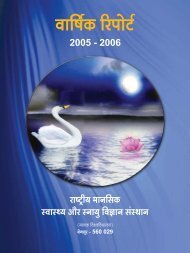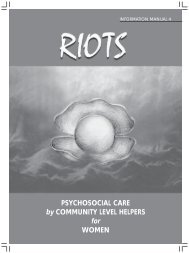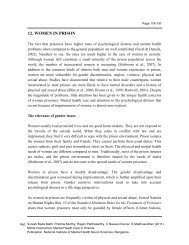An illicit alcohol production center in rural Bangalore - Nimhans
An illicit alcohol production center in rural Bangalore - Nimhans
An illicit alcohol production center in rural Bangalore - Nimhans
Create successful ePaper yourself
Turn your PDF publications into a flip-book with our unique Google optimized e-Paper software.
dr<strong>in</strong>k<strong>in</strong>g occasion) were significantly more likely to suffer emotional problems like depression and<br />
anxiety, stomach pa<strong>in</strong> presumably <strong>in</strong>dicative of <strong>alcohol</strong> related erosive gastritis, and other somatic<br />
problems like headache and generalized aches and pa<strong>in</strong>s. While not statistically significant this<br />
population also reported more frequent heart ailments, diabetes and <strong>in</strong>creased blood pressure.<br />
Alcohol users, both male (78%) and female (75%) were also more likely to use various forms of<br />
tobacco than non-users (22% and 8% respectively), thus <strong>in</strong>creas<strong>in</strong>g the risk of health damage.<br />
6. Costs of <strong>alcohol</strong> use<br />
Alcohol users spend more than a fourth of their monthly family <strong>in</strong>come on <strong>alcohol</strong><br />
Alcohol users spent an average of more than Rs. 400 per month on <strong>alcohol</strong>. This amounted to more<br />
than a fourth of their monthly family <strong>in</strong>come. These are merely a fraction of direct costs due to<br />
<strong>alcohol</strong> use. The social cost [direct + <strong>in</strong>direct costs] is likely to be significantly more. <strong>An</strong> earlier<br />
study <strong>in</strong> this same population estimated that the social cost due to the <strong>alcohol</strong> dependent population<br />
alone (less than 4% of the adult male population) to be around Rs. 18000 million [1997 figures].<br />
If one extrapolates this monthly cost to the presumed 5.11 million consumers <strong>in</strong> the state, one<br />
arrives at an annual spend on <strong>alcohol</strong>ic beverages amount<strong>in</strong>g to Rs. 25386.50 million.<br />
Rural consumers were also more likely to spend a greater proportion of their family <strong>in</strong>come on<br />
<strong>alcohol</strong> than urban consumers.<br />
7. Gender aspects of <strong>alcohol</strong> use<br />
There are strik<strong>in</strong>g gender differences relat<strong>in</strong>g to <strong>alcohol</strong> use, <strong>alcohol</strong> expectancies, stigma and<br />
health consequences due to <strong>alcohol</strong> use<br />
Women consumers usually have their <strong>in</strong>itial dr<strong>in</strong>k and beg<strong>in</strong> regular dr<strong>in</strong>k<strong>in</strong>g at significantly later<br />
ages than men. This is strik<strong>in</strong>gly different than <strong>in</strong> the case of tobacco where such a wide difference<br />
<strong>in</strong> age at <strong>in</strong>itiation of use is not seen between men and women. This is a further comment on how<br />
unacceptable the use of <strong>alcohol</strong> is <strong>in</strong> Indian society, compared to that of tobacco products.<br />
What is strik<strong>in</strong>g, <strong>in</strong> comparison to comparable figures from other countries, is that when women<br />
dr<strong>in</strong>k, they tend to match the men, dr<strong>in</strong>k for dr<strong>in</strong>k, so to speak. Average quantities drunk dur<strong>in</strong>g<br />
typical dr<strong>in</strong>k<strong>in</strong>g occasions are roughly the same. As discussed above, these quantities tend to be<br />
large, 5 or more standard dr<strong>in</strong>ks on average per occasion !<br />
The difference lies <strong>in</strong> the frequency of dr<strong>in</strong>k<strong>in</strong>g occasions, with women dr<strong>in</strong>k<strong>in</strong>g on far fewer days<br />
of the month than the men.<br />
The health implications are grave. It is well appreciated (Heath,2000; Stockwell et al, 1996) that<br />
b<strong>in</strong>ge dr<strong>in</strong>k<strong>in</strong>g and dr<strong>in</strong>k<strong>in</strong>g to <strong>in</strong>toxication are associated with more adverse consequences,<br />
particularly acute consequences. There is also mount<strong>in</strong>g evidence that women suffer earlier and<br />
relatively graver medical and physical consequences, at lower doses of ethanol than men.<br />
In an unpublished study of female <strong>alcohol</strong>ics <strong>in</strong> this same population (Murthy, et al. personal<br />
communication) the average age at onset of use <strong>in</strong> women was significantly later than that <strong>in</strong> males,<br />
however, the age at which both males and females had developed severe enough problems which<br />
prompted them to seek help for the first time were quite similar. This f<strong>in</strong>d<strong>in</strong>g is <strong>in</strong> keep<strong>in</strong>g with<br />
most of the 'Western' literature which po<strong>in</strong>ts to a more rapid development or "telescop<strong>in</strong>g" of the<br />
course of <strong>alcohol</strong> related illness <strong>in</strong> women.Aga<strong>in</strong>, women were significantly more likely to present<br />
with co-morbid psychiatric symptoms or dual diagnoses than the men. Depression and depressive<br />
disorder were significantly high. Physical complications , especially gastritis and anemia were also<br />
much higher than <strong>in</strong> their male counterparts. Women appear to develop late-stage physical damage<br />
more rapidly than men and have a higher prevalence of psychiatric dual diagnoses.<br />
In a sense this is evident from the data <strong>in</strong> this study as well. Women consumers had a higher<br />
prevalence [albeit statistically non-significant ] of significant illness <strong>in</strong> the past year than the men.<br />
84





